Energy Savings: Insights and Innovation
- By Jason Mellard, Nathan Hart
- 12/01/16
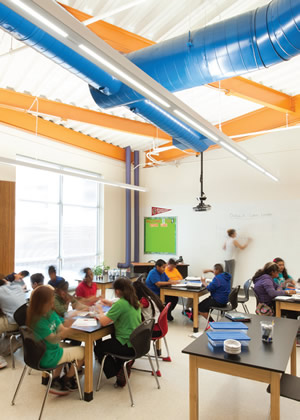
PHOTO © SELSO GARCIA
According to the U.S. Environmental Protection
Agency (EPA), the cost of energy is the
second highest operating expense for school districts
around the country after personnel. Furthermore,
the EPA estimates that 25 percent of
energy use in schools is wasted. As U.S. schools
continue to face increasing budget pressures,
implementing strategies for energy savings can
have a significant positive impact on the bottom
line for school districts. By implementing policies
for energy use reduction in new construction,
renovation as well as in building operations and
maintenance, school districts can direct much-needed
funds to student services and personnel.
Effective use of bond dollars in new construction
and renovation provides the greatest
impact on energy savings over the life of a
building. Energy efficient, sustainable design
must be incorporated from a project’s inception
to be most effective in decreasing life cycle
costs. Site selection, building orientation, mechanical
systems, efficient building envelopes
and low-maintenance materials are some of the
key considerations in campus design.
Additionally, the use of energy modeling early
in design can help inform big picture design decisions
from the outset regarding orientation and
sunlight. Finally, close collaboration between the
architect, consultants (i.e. MPE engineer, structural
engineer, civil engineer) and contractor fosters
good communication and helps to ensure a
whole systems approach to the design.
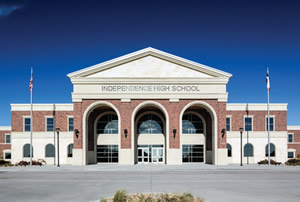
PHOTO © INDEPENDENCE PROFESSIONAL PHOTO
Seeing the light
According to the EPA, artificial lighting
consumes an average of 25 percent of a school’s
energy. Being considerate of the mix of artificial
and natural lighting in school design can have
a significant impact on energy costs. Automatic
daylight harvesting, vacancy sensors and dual
controls in the classrooms limit the number of
switches users need to control. In recent years,
LED lighting has become more competitive in
cost when compared to fluorescent lighting at
a fraction of the energy cost. Dimming is more
easily incorporated in LED systems and additional
wiring costs are minimized.
In addition to looking for ways to minimize
costs in artificial lighting, priority should also be
placed on designing to maximize natural light
in schools. Natural light in classrooms has been
shown to increase test scores and student focus.
In fact, a study by the Northwest Energy Alliance found that students in rooms with the most diffuse and glare-fee daylight
improved performance on standardized tests by up to 26 percent.
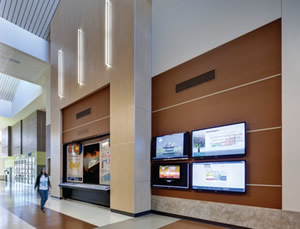
PHOTO © CHARLES DAVIS SMITH
Air and Temperature Control
After lighting, mechanical systems account for the most energy
usage in buildings. Additionally, high-quality indoor air has been
shown to have the greatest effect on student performance and attendance
along with natural lighting. HVAC system selection should
take into account the size, shape and program of the building. There
are many different mechanical system types available. The best system
is the one that: 1) can be properly maintained by the district
maintenance staff, 2) is energy efficient, 3) will fit the site constraints
and 4) will meet the budget limitations of the project. With any mechanical
system type selection, it is important to be sure to meet or
surpass the minimum outside air ventilation requirements for the
space. This outside air requirement often places the largest load on
HVAC systems and needs to be considered as an integral part of any
system. Pre-treat systems, energy recovery ventilation, and return air
tempering should all be taken into consideration.
Some of the more energy efficient systems utilized in the Southern
United States include Geothermal (Ground Source) Heat Pumps
and Variable Refrigerant Flow (VRF) systems. However, these systems
can sometimes be more expensive to incorporate. Some of
the less expensive, historically less efficient HVAC systems such as
packaged Roof-Top Units (RTUs) now have options for significantly
higher efficient equipment offerings. Instead of settling for 13 Seasonal
Energy Efficiency Ratio (SEER) efficient RTUs, higher efficient
20-23 SEER units can be installed for a minor cost increase per
unit. Through the use of variable speed motors, multi-stage compressors,
and other improvements, these new systems can make a
dramatic difference in a building’s energy usage, especially in an
equipment replacement project.
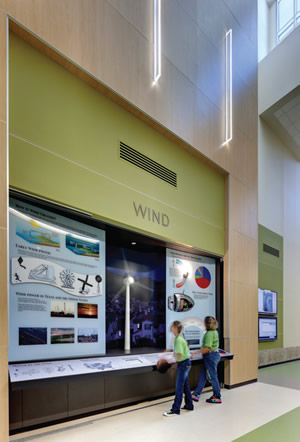
PHOTO © CHARLES DAVIS SMITH
After careful siting of the building and selection of appropriate
lighting and HVAC systems, the building envelope itself has the potential
to save energy dollars. High performance walls, openings, and
roof assemblies are continuously improving through code requirements
and competition. Building codes are requiring not only higher
R-values in roofs and walls, but also continuous insulation (unbroken
by studs or framing) for new construction. New technologies such as
Insulated Concrete Form (ICF) walls can be considered as well.
Insulated Concrete Form exterior walls (ICF) are being more
widely used in school design. This system is composed of two layers
of rigid insulation formwork, which is filled with a layer of concrete
poured in between. These walls provide up to an R-40 insulation
value, reducing heating and cooling loads significantly. They reduce
indoor allergens by limiting air infiltration and allow for a quieter
indoor environment. ICF walls are inherently more rigid and durable
when it comes to impact resistance, providing greater protection
from tornadoes, hurricanes and fires. The concrete also has a longer
lifespan than conventional wall construction, creates less waste
and increases the speed of construction beyond the typical pace for
CMU or stud framed construction.
In conjunction with the wall assembly, a designer
should evaluate heat transfer through the roof, crawl space
and window openings. These should have an R-value that
is complementary to the walls for the overall envelope to be
the most effective. Consider increasing the roof insulation
design from R-20 to an R-30 highly reflective roof in order
to ensure the energy efficiency of the roof approached that
of the high performing walls. Proper flashing and sealing
of windows reduces air and water infiltration. It is also
important to select glazing with a low solar heat gain and
shading coefficient. For optimal performance, exterior
sun control should be provided on openings through the
use of louvers, sun shades, and overhangs.
Frisco ISD’s Independence High School designed by
Corgan, is a 2,100-student comprehensive high school
designed with insulated concrete form wall construction.
In combination with a geothermal heating and
cooling system, LED lighting, and careful building
layout and siting, the campus uses over 50 percent less
energy than Frisco ISD’s similar-sized Centennial high
school, built eleven years prior. The district has opened
an additional nine other ICF schools since 2014, and has
four more currently under construction.
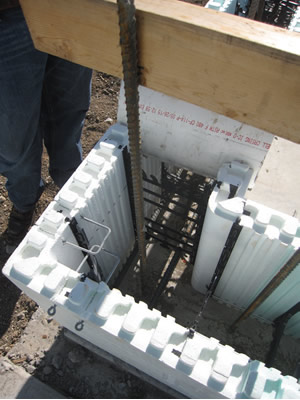
PHOTO COURTESY OF CORGAN
Sealing the Envelope. Insulated Concrete Form
(ICF) exterior walls provide high R values and
continuous insulation due to the lack of studs and
framing. They are becoming more common in
school design. The ICF system is composed of two
layers of rigid insulation formwork that is filled with
a layer of concrete poured in between. The walls
provide up to an R-40 insulation value, reducing
heating and cooling loads significantly. They reduce
indoor allergens by limiting air infiltration and allow
for a quieter indoor environment.
It Takes a Village
When developing district standards for building construction
and maintenance, one should do so in tandem
with the staff “holding the tools.” The staff knows the
school best; they should be included in design development
and trained on new technologies. “Education is key to empowering
maintenance staff,” says Jerry Palermo, energy
manager for Grand Prairie Independent School District.
“Understand that after all the engineers and contractors are
gone, they are the ones that have to care for the building.”
A successful energy management plan involves not only
maintenance and operations staff, but also administrators, teachers, students, the community and designers. Education and awareness
are powerful tools to create buy-in from everyone. Clear goals and
baseline analysis allow for clear measurement of savings over time. To
aid in this effort for their district, both Frisco ISD and Arlington ISD have
developed websites where students, staff and the community can view
detailed data regarding water, natural gas and electricity consumption
of the district’s buildings. Sustainable practices and systems can also be
impactful teaching tools for students. Leaders should provide transparency
to students and teachers as to the power usage they generate.
Systematic energy audits can also be effective in reminding users
of the impact they have to control energy costs. Eliminating
microwaves, space heaters, refrigerators and printers from classrooms,
turning off computers and lights throughout buildings and
dialing back the thermostat during off-peak hours have a big effect
on the bottom line. A staff member should walk every roof a school
periodically to ensure their school is not underperforming.
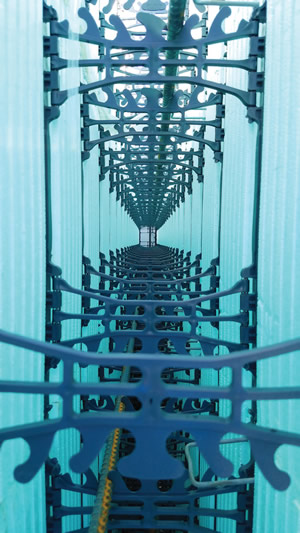
PHOTO COURTESY OF CORGAN
Finally, paying attention to the energy bill is important. One
should compare current trends with those from the past to set a
baseline for energy saving strategies and potential audits or facility
upgrades. To aid in this comparison, energy consumption meters
can be provided at the main electrical, water, and gas service to a
facility and monitored to closely track consumption. Energy penalties
can be incurred without notice, such as when a school’s power
factor drops below a certain power quality percentage (usually below
90 percent). Power factor capacitors allow a building to utilize
power more efficiently and pay for themselves quickly by reducing
penalties from energy providers.
Maintenance is Key
A 2011 McGraw-Hill study noted that the average age of school
buildings in the United States is 42 years — which is nearly the expected
serviceable lifespan of a school building. Facility assessments
can help to determine whether pouring additional money into an existing
building will pay off in the long run. Depending on the extent
of work proposed, existing building codes may require increasing the
amount of outside air into the building (potentially requiring new air
handlers and increased duct sizes), upgrading lighting controls and
fixtures and upgrading plumbing fixtures to meet new water usage
standards. Administrators should use renovations as targeted opportunities
to upgrade existing systems for greater performance over
time. For instance, one might defer a total building overhaul and instead
replace an aging roof assembly with a more energy-efficient one.
Many grants and incentives are also available for school districts.
Rebates are available for converting existing lighting systems
to current standards or replacing older HVAC equipment with
newer and more efficient equipment. The State of Texas, through
the State Energy Conservation Office (SECO), has provided multiple
grants to smaller districts to replace older lighting and HVAC
systems and provide solar power. One of the larger electrical distributors
in Texas has provided rebates for higher efficiency HVAC
equipment, lighting, high efficiency roof, high efficiency window
glazing, and other energy efficient building systems. Grand Prairie
ISD is currently closing out their summer 2016 projects with the
Oncor energy efficiency incentive program, and the utility company
will compensate GPISD upon Oncor’s inspection of the energy saving
measures incorporated into the design.
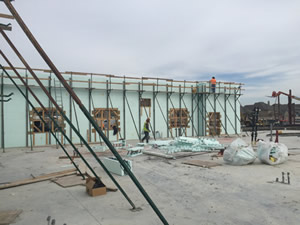
PHOTO COURTESY OF CORGAN
Accurate and accessible as-built documents, product manuals
and warranties allow for ease of troubleshooting and maintenance
schedules. Recordkeeping software, such as the Project Documentation
Software by Ex3 Facility Solutions, can pinpoint specific
equipment types, controls and locations installed in each school,
reducing time and road-blocks to properly maintain facilities.
In Conclusion
Energy efficient design can have a truly positive effect on our
schools. In these times of increased financial scarcity and scrutiny,
thoughtful approaches to energy saving can help direct resources
back to personnel and students, creating a meaningful impact on
students, schools, districts and communities.
This article originally appeared in the issue of .